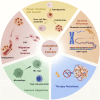Exploring lactylation and cancer biology: insights from pathogenesis to clinical applications
- PMID: 40584966
- PMCID: PMC12202587
- DOI: 10.3389/fcell.2025.1598232
Exploring lactylation and cancer biology: insights from pathogenesis to clinical applications
Abstract
As a byproduct of glycolysis, lactate functions as a signaling molecule, a substrate for energy metabolism, and a regulator of the tumor microenvironment (TME). It is involved in various biological processes, including energy shuttling, tumor growth and invasion, drug resistance, and immune evasion. Lactylation, a recently identified post-translational modification (PTM), acts as a bridge between gene regulation and cellular metabolism, thus playing a crucial role in tumor biology. Similar to other epigenetic modifications, lactylation influences the spatial conformation of chromatin, modulates DNA accessibility, and regulates gene expression. It intricately participates in TME-related processes by orchestrating immune state transitions and enhancing the malignant characteristics of tumors. This review summarizes lactylation-related genes in tumors, the role of lactylation in the TME, the interactions of the genes with other metabolic pathways, and the potential mechanisms underlying tumor progression as well as their clinical implications. Despite its nascent stage, research on the epigenetic regulation of tumor-related genes by lactylation holds promise. In this review, we highlighted unresolved challenges in this field and provided insights that may guide the development of novel targeted therapies for cancer.
Keywords: lactylation; post-translational modification; prognostic biomarkers; therapeutic target; tumor progression.
Copyright © 2025 Gou, Sun and Li.
Conflict of interest statement
The authors declare that the research was conducted in the absence of any commercial or financial relationships that could be construed as a potential conflict of interest.
Figures
Similar articles
-
Research progress on the interaction between glucose metabolic reprogramming and lactylation in tumors.Front Immunol. 2025 Jul 14;16:1595162. doi: 10.3389/fimmu.2025.1595162. eCollection 2025. Front Immunol. 2025. PMID: 40755753 Free PMC article. Review.
-
Lactylation and its roles in diseases: a systematic bibliometric exploration of the research landscape.Front Oncol. 2025 Jul 2;15:1569651. doi: 10.3389/fonc.2025.1569651. eCollection 2025. Front Oncol. 2025. PMID: 40672754 Free PMC article.
-
Lactate and lactylation modifications in neurological disorders.Neural Regen Res. 2025 Jun 19. doi: 10.4103/NRR.NRR-D-24-01344. Online ahead of print. Neural Regen Res. 2025. PMID: 40537007
-
The lactylation-macrophage interplay: implications for gastrointestinal disease therapeutics.Front Immunol. 2025 Jul 9;16:1608115. doi: 10.3389/fimmu.2025.1608115. eCollection 2025. Front Immunol. 2025. PMID: 40703527 Free PMC article. Review.
-
Navigating the role of protein lactylation in prostate cancer and its implications for immunotherapy.J Cancer. 2025 Jun 12;16(8):2706-2719. doi: 10.7150/jca.114137. eCollection 2025. J Cancer. 2025. PMID: 40535811 Free PMC article. Review.
References
Publication types
LinkOut - more resources
Full Text Sources
Research Materials




